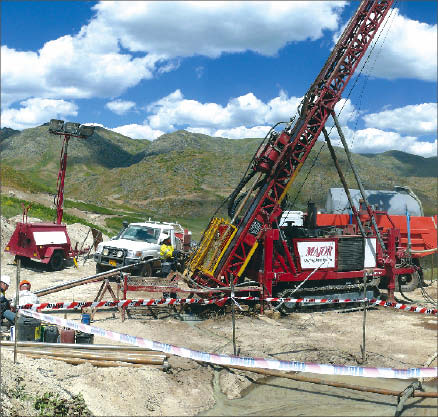A definitive feasibility study on the Karchiga volcanogenic massive sulphide deposit in northeastern Kazakhstan demonstrates that the project can be developed as a high-grade, medium-cost open-pit copper mine with a rapid payback period, London-based Orsu Metals (OSU-T) says.
The proposed mine is expected to produce 328 million payable lbs. copper over its 11.5-year mine life, with an average of 28.57 million lbs. copper production a year. Construction is slated for the third quarter and Orsu anticipates building the processing facilities and completing pre-production development work within a 12- to 15-month period.
Initial capital expenditures — excluding the solvent-extraction and electrowinning (SX-EW)plant, and sustaining capital and closure costs — has been estimated at US$115 million, which can be paid back in just under three years. Total capital expenditure is estimated at US$147 million.
The base and precious metals exploration and development company acquired the project licence in 2007, and owns 95% of the project.
Karchiga’s post-tax net present value rings in at US$150 million, with a 30% internal rate of return based on a copper price of US$3.25 per lb.
The mining schedule envisages mining 10 million tonnes of sulphide and oxide ore and 124 million tonnes of waste, with a 12.4-to-1 stripping ratio over the mine life. The operation’s average mining rate would be 750,000 tonnes per year.
During the first 2.25 years, there would be open-pit mining on the Central sulphide orebody to maximize the sulphide copper grade and recovery. The optimized mine schedule was developed to lower the stripping ratio in the first three years of mining.
The company can increase the processed ore grade through stockpiling. From year four until year seven, sulphide ore would be mined from the Central and North East open pits. From year eight until the end of the mine life in year 12, all mining would continue in the North East pit.
The plant is designed to process 750,000 tonnes of sulphide ore each year. A conventional processing route was chosen using fine grinding and selective sulphide flotation to produce a 27.9% bulk concentrate. First production is scheduled in late 2013, with final production in 2025.
Copper from the oxide ore will be extracted using the SX-EW process. The oxides would be treated over four-and-a-half years beginning in 2018 at a 360,000-tonne annual production rate. The company expects to produce 6.22 million lbs. copper cathode a year during that period.
In order to trim initial capital costs, building the SX-EW plant has been delayed until after the 2.75-year capital expenditure payback period. The plant has been designed to treat 30,000 tonnes of leachable oxide ore per month.
The feasibility study results seem to demonstrate that the best economic option is to delay SX-EW construction until 2017, allowing Orsu to pay building costs from revenues generated by sulphide-ore treatment.
The project contains 10.8 million tonnes of indicated resources with sulphide and oxide mineralization grading 1.73% copper for 412.7 million contained lbs. copper, with inferred resources adding 0.02 million tonnes of sulphide mineralization grading 1.28% copper for 0.7 million contained lbs. copper.
Using only the indicated resource estimate, the definitive feasibility study supports an 8.5-million-tonne probable sulphide reserve estimate in the Central and Northeast pits for 320 million contained lbs. copper at a 1.71% average copper grade amenable to flotation, and l 1.5 million tonnes of ore in the Central pit with 47.2 million contained lbs. copper at an average 1.43% copper grade amenable to heap leaching.
The Karchiga project is 40 km west of the China-Kazakshtan border and 50 km north of the Irtysh River. It is also 250 km southeast of the regional Ust-Kamenogorsk administrative centre and 120 km southeast of the Kurchum township. Altai, the nearest village, is 8 km from the deposit.
Karchiga is 10 km from a main road and can be connected to a 110-kilovolt national power grid nearby. The company says water supply from the Kalzhir River would be adequate for the project and that water can also be sourced from tha area’s aquifers.
The Karchiga deposit lies within the Vavilon-Karchiga zone of the northwest-striking, mid-Palaeozoic Rudny Altai volcanogenic massive sulphide (VMS) belt, which hosts numerous VMS deposits including Leninigorsk, Zyryanovsk and Maleevsky. The Rudny Altai VMS terrane is ranked in the top four VMS belts of the world, the company states.
The deposit was first explored in 1936 and again from 1941 to 1942, when the first historic resource was completed. The Soviets explored it more thoroughly in the 1950s during which time 104 holes were drilled for a total of 18,500 metres, along with 33 trenches totalling 2 km.
News of the feasibility study sent shares of Orsu up 1.5¢, or 9.1%, to close at 18¢ a share on 1.4 million shares traded. Over the last year Orsu has traded between 9.5¢ and 31¢. The junior has 158 million shares outstanding.


Be the first to comment on "Karchiga feasibility lifts Orsu Metals"